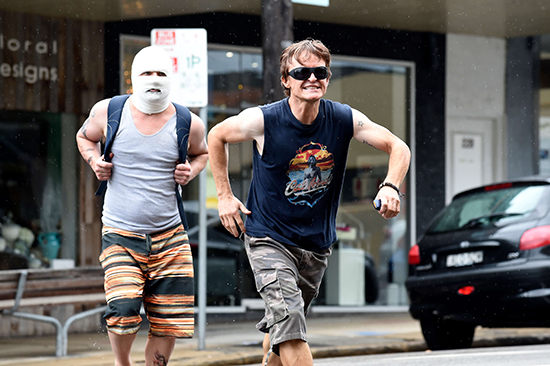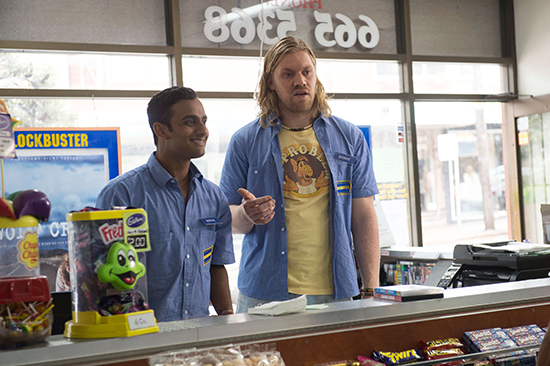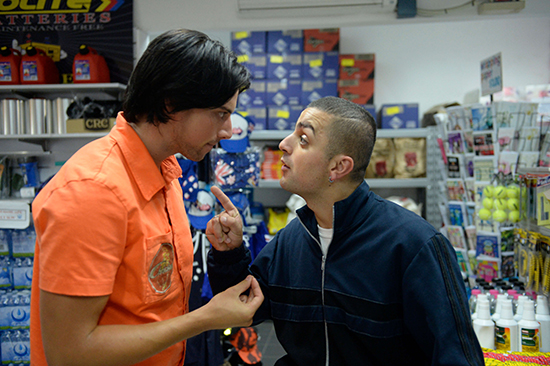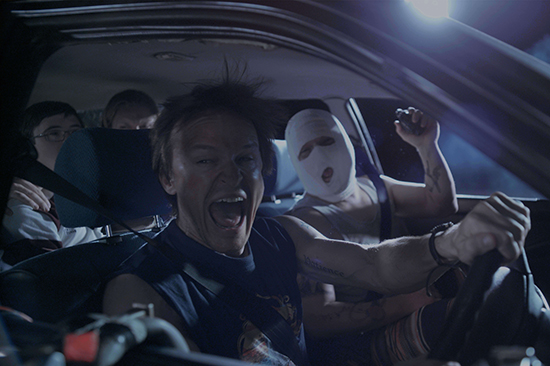Racism laid bare: not so funny
Katerina Sakkas: Abe Forsythe’s Down Under

Down Under
On 11 December 2005, a crowd of approximately 5000 mostly young white men converged on the Sydney beachside suburb of Cronulla with the aim of ‘taking back’ the beach from what they saw as an encroaching Middle Eastern community. Escalating into attacks against lone Middle Eastern men, this initial riot kicked off retaliatory violence in the following days, both in Cronulla and other suburbs. Opening with grotesque documentary footage of the event, Abe Forsythe’s dark comedy Down Under propels us back to an ugly period at a time when organised racism is again gaining traction in this country.
The film follows two groups of men, one made up of Anglo-Australians, the other Lebanese, both seeking retribution in the wake of the riot. Each group contains a more reluctant member: Hassim, a diligent student (Lincoln Younes) and amiable stoner “Shit-Stick” (Alexander England). With a misguided sense of familial loyalty, each ultimately succumbs to the zealots surrounding him. While Down Under’s scenario is mired in its characters’ bigotry, it’s also a study in the sort of toxic masculinity that defines itself through clannishness and violent exclusion of the other.

Down Under
All sorts of strutting, posturing masculinities are unflatteringly displayed: the beer-swilling ‘Aussie’ numbskulls are virulently racist, but some of the Lebanese cohort are just as quick to lash out at innocent bystanders. A gay underworld clique of bare-chested South-East Asian men led by a camp white Australian (David Field) flaunts its potential for violence along with its pecs. Forsythe assembles all the markers of male aggression: cars, alcohol, weapons, the promise of a fight and the desire to link incipient thuggery to some vaguely articulated greater cause—the legacy of Gallipoli, or of Ned Kelly.
Down Under’s subject is as grim as any other Australian film examining toxic masculinity in the context of actual events, but unlike The Boys or Snowtown, which would have been obscene as comedies, Forsythe gets away with his unsubtle humour because his subjects are dangerous buffoons rather than calculatedly evil. The joke, sour as it is, is on them. The gags in Down Under are for the most part heavy-handed and reliant on stereotypes, a case in point the token ‘Aussie’ girlfriend who’s a foul-mouthed, heavily pregnant chain-smoker. Elsewhere, it’s the characters’ sheer offensiveness that’s meant to be funny, though laughing at those whose speech is a barrage of crude bigotry can feel uncomfortably close to laughing along with them.

Down Under
Despite drawbacks in some of the writing, Forsythe has gathered a compelling cast whose performances transcend caricature. The film’s cinematography, editing and pacing convey a pulsing energy and ominousness. Once the warring factions hit the road, the heady build-up to confrontation is captured with sickening immediacy. Lachlan Milne’s cinematography perfectly combines night-time suburbia and rampant testosterone as a car, viewed aerially, does 360 degree burnouts, smoke pluming while that menacing ode to female seduction, Kelis’ “Milkshake,” plays over the top. Claustrophobic scenes in crowded cars show a revolving tableau of sweat-dripping, lank-haired figures caught mid-yell. In these moments the film’s comedy and seriousness coalesce in a vision of adrenalised ridiculousness.
The characters in Down Under may be clueless and inept, but they’re not softened around the edges. The film doesn’t pull its punches when showing the consequences of knee-jerk behaviour, whether fuelled by hatred, misguided loyalty or a wish to belong. In one scene, the white Australians sing along to the title track from 80s fantasy film The Neverending Story—a timely reminder that the lessons of the Cronulla Riots are yet to be learnt.

Down Under
Down Under, writer, director Abe Forsythe, cinematographer Lachlan Milne, music Piers Burbrook de Vere, editor Drew Thompson, production design Nicholas Dare, distributor StudioCanal, 2016
RealTime issue #134 Aug-Sept 2016






